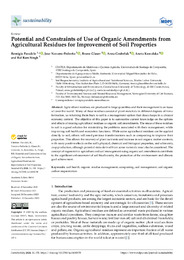Por favor, use este identificador para citar o enlazar este ítem:
https://hdl.handle.net/11000/37884Registro completo de metadatos
| Campo DC | Valor | Lengua/Idioma |
|---|---|---|
| dc.contributor.author | Paradelo, Remigio | - |
| dc.contributor.author | Navarro-Pedreño, Jose | - |
| dc.contributor.author | Glaser, Bruno | - |
| dc.contributor.author | Grobelak, Anna | - |
| dc.contributor.author | Kowalska, Aneta | - |
| dc.contributor.author | Singh, Bal Ram | - |
| dc.contributor.other | Departamentos de la UMH::Agroquímica y Medio Ambiente | es_ES |
| dc.date.accessioned | 2025-11-06T08:54:57Z | - |
| dc.date.available | 2025-11-06T08:54:57Z | - |
| dc.date.created | 2023-12-22 | - |
| dc.identifier.citation | Sustainability 2024, 16(1), 158 | es_ES |
| dc.identifier.issn | 2071-1050 | - |
| dc.identifier.uri | https://hdl.handle.net/11000/37884 | - |
| dc.description.abstract | Agricultural residues are produced in large quantities and their management is an issue all over the world. Many of these residues consist of plant materials in different degrees of transformation, so returning them back to soil is a management option that closes loops in a circular economy context. The objective of this paper is to summarize current knowledge on the options and effects of reusing agricultural residues as organic soil amendments. The reuse of these residues in soil is a good solution for minimizing the problems associated with their management, while improving soil health and ecosystem functions. While some agricultural residues can be applied directly to soil, others will need previous transformations such as composting to improve their properties. This allows the recovery of plant nutrients and increase in soil organic matter contents, with many positive effects on the soil’s physical, chemical and biological properties, and ultimately, crop production, although potential risks derived from some materials must also be considered. The concept of regenerative agriculture and soil management using organic soil amendments contribute to the significant enhancement of soil biodiversity, the protection of the environment and climate goal achievement. | es_ES |
| dc.format | application/pdf | es_ES |
| dc.format.extent | 18 | es_ES |
| dc.language.iso | eng | es_ES |
| dc.publisher | MDPI | es_ES |
| dc.rights | info:eu-repo/semantics/openAccess | es_ES |
| dc.rights | Attribution-NonCommercial-NoDerivatives 4.0 Internacional | * |
| dc.rights.uri | http://creativecommons.org/licenses/by-nc-nd/4.0/ | * |
| dc.subject | soil health | es_ES |
| dc.subject | organic residue management | es_ES |
| dc.subject | composting | es_ES |
| dc.subject | soil management | es_ES |
| dc.subject | soil organic carbon sequestration | es_ES |
| dc.subject.other | CDU::5 - Ciencias puras y naturales | es_ES |
| dc.title | Potential and Constraints of Use of Organic Amendments from Agricultural Residues for Improvement of Soil Properties | es_ES |
| dc.type | info:eu-repo/semantics/article | es_ES |
| dc.relation.publisherversion | https://doi.org/10.3390/su16010158 | es_ES |

Ver/Abrir:
15_sustainability-16-00158.pdf
931,86 kB
Adobe PDF
Compartir:
 La licencia se describe como: Atribución-NonComercial-NoDerivada 4.0 Internacional.
La licencia se describe como: Atribución-NonComercial-NoDerivada 4.0 Internacional.
.png)